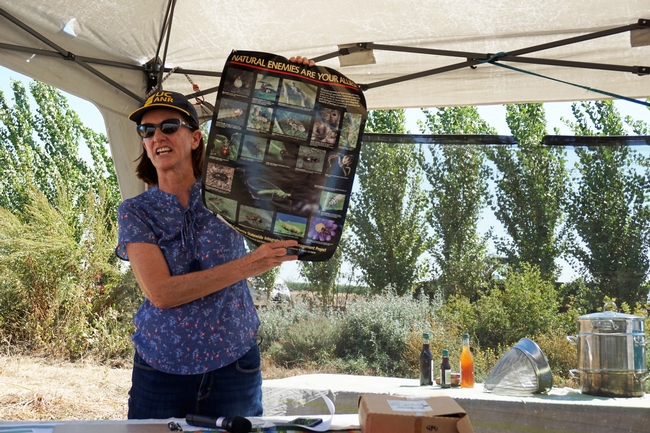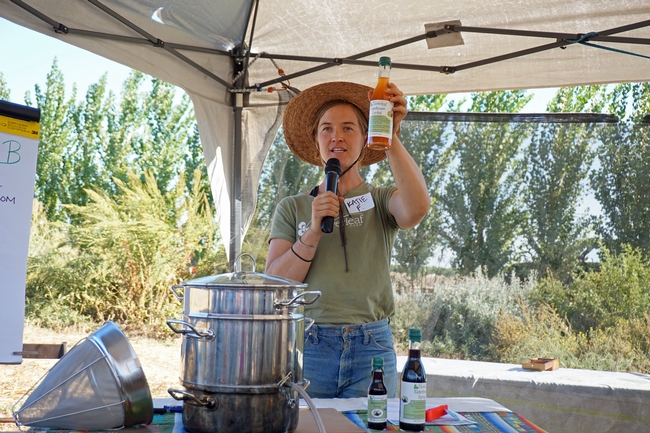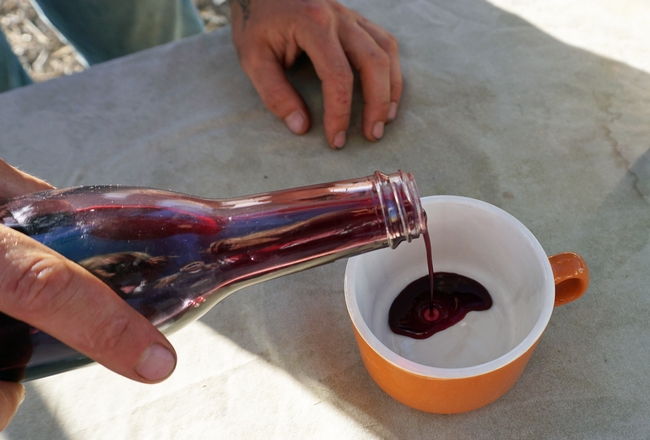California elderberries have rich benefits for farms and diets
Native California elderberries can be found at the intersection of sustainable farming, super nutrition and economic viability. Naturally drought tolerant, flavorful and packed with nutrients, they are capturing the interest of farmers, health-conscious consumers and scientists.
Elderberries were the focus of a field day offered by UC Agriculture and Natural Resources Sustainable Agriculture Research and Education Program (SAREP) in September at Cloverleaf Farm, an organic berry and tree fruit operation in Dixon.
Elderberries occur naturally around the world. In California, Native Americans used the tree's stems for making flutes, berries for food and purple dye, and bark, leaves and flowers for their purported anti-inflammatory, diuretic and laxative properties.
“They had a relationship with the plant for food, medicine and music,” said SAREP academic coordinator Sonja Brodt. “We wish to honor the elderberry's history here and thousands of years of management by California native tribes.”
UC Cooperative Extension advisor Rachael Long said elderberries are her favorite native plant.
“They're pretty in the spring and summer. The flowers smell like cloves. It's a wonderful fragrance,” she said.
But perhaps the best attribute of elderberries for Long, a proponent of planting hedgerows on the edges of farmland, is the tree's ecological benefits. Elderberries can be among the rows of trees, shrubs, grasses and sedges in hedgerows that attract beneficial insects and pollinators to farms to help with biocontrol of pests and pollination of plants in adjacent crops.
“Flowering native plants like elderberries, toyon, Christmas berry, coffee berry, manzanita and coyote brush provide nectar and pollen for native bees, honey bees and other insects,” Long said. “I see a lot of green lace wings (predators of aphids, spider mites and other pests) in elderberry.”
Long reported that a tomato farm didn't have to spray as much for aphids because of the beneficial insects attracted by the hedgerow. “They saved $300 per acre each year,” she said.
Hedgerows require long-term planning and care, including weed control. Establishing a hedgerow costs about $4,000 for a 1,000-foot-long planting with a single row of shrubs and trees bordered by native perennial grasses. At that rate, Long has calculated that a return on investment in pest control takes about 15 years. For pollination, the return on investment is about 7 years.
Installation of hedgerows can be eligible for cost sharing with USDA's Natural Resources Conservation Service Environmental Quality Incentives Program. Costs can also be offset by harvesting the elderflowers and elderberries in the hedgerow and making value-added products – such as syrups and jams – or selling the flowers or berries to a processor.
Farmer Katie Fyhrie shared how Cloverleaf Farm is managing elderberries in a hedgerow, harvesting flowers in the spring to make and bottle elderflower cordial, and harvesting berries in the fall to produce and bottle deep purple sweet-tart syrup. Sixteen ounce bottles of cordial and syrup sell for $12 each. The cordial and syrup are ideal for serving with seltzer and ice for a fruity and uniquely wild-tasting drink.
Fyhrie is also working with Brodt of SAREP to gather data for research on best production practices, farm and processing labor costs, and yield comparison between native plants and named varieties from the Midwest. The study includes data from three California farms.
The project is a collaboration among the UC Sustainable Agriculture Research and Education Program (a program of the Agricultural Sustainability Institute at UC Davis), the UC Agricultural Issues Center, the UC Davis Department of Food Science and Technology and four farmers to assess the farm management practices, cost, nutritional content, and market potential of California elderberries.
While laboratory research comparing the nutritional characteristics of the California blue elderberry with the North American black and the European black is continuing at UC Davis, food science professor Alyson Mitchell and her graduate student Katie Uhl were able to share what is already known about the nutritional benefits of the fruit.
They said elderberries are high in vitamin C, dietary fiber, phenolic acids and anthocyanins. Elderberries contain antibacterial, antioxidant and anti-inflammatory agents. While they have a strong history as a treatment for colds and flu, more studies are needed to understand their medicinal use, Mitchell said.
The field day in Dixon was among the first outcomes of the two-year project. A growers' production guide, cost of production study, an assessment of market demand and nutritional analyses are also planned. The information will be made available, along with other resources on elderberry cultivation and processing, on the ASI website.
Comments:
I would check ahead with the nursery though, to make sure they have some in stock.
You might also want to check with your local Resource Conservation District, as they may be ordering elderberry for restoration or hedgerow projects.





Posted by Caroline Szekely on February 4, 2021 at 1:26 PM